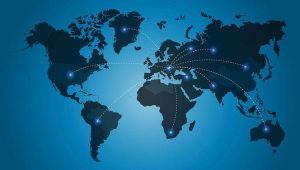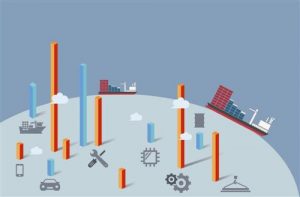Trends in global trade liberalization

The theory of international trade liberalization. According to the actual situation today, the comparative advantage of developing countries is labor, so they should produce labor-intensive products (such as clothing) in exchange for capital-intensive products (such as machine tools); in contrast to developed countries, their comparative advantage is Capital and technology, so capital-intensive products (such as cars) should be produced in exchange for labor-intensive products (such as food). Through this division of labor, countries can achieve the optimal allocation of resources, thereby maximizing economic benefits. Of course, because obstacles between countries cannot be completely eliminated (such as the free movement of labor), and national security considerations (such as the need for a certain degree of self-sufficiency in food production), it is impossible to achieve a complete international division of labor, so in reality In an incomplete division of labor. The problem is that this incomplete division of labor should eliminate obstacles to the greatest extent and achieve free trade as much as possible.
Compared with the incomplete division of labor, the more important problem is that countries tend to adopt protectionist measures, including setting import tariffs and import quotas, as well as technical, safe, sanitary and other restrictions. At the same time, many measures have been taken to encourage exports and restrict imports, such as subsidizing export companies, providing low-interest loans to foreign companies buying domestic exports, and dumping. What these measures and policies have in common is to restrict imports and encourage exports, with the result that they distort commodity prices, reduce (or improperly expand) trade volumes, reduce efficiency, and reduce returns. Most protectionist measures restrict imports and encourage exports, which is a reflection of mercantilist thinking and a lack of security. Mercantilism advocates the idea that international trade is over, and importing precious metals is a kind of zero-sum game. They have not seen the side of international division of labor and equal trade that can promote economic growth, that is, they do not know that free trade can increase wealth.
Many people do not understand that the original intention of countries to adopt trade protection measures is to protect their own interests, but the original intention cannot be achieved as a result, often contrary to expectations. First, restricting the import of foreign goods does not necessarily promote domestic exports. Because it is the lack of competitiveness of domestic products that leads to unsound exports and even deficits. Taxing foreign products does not improve the competitiveness of domestic products. Second, the taxation of foreign goods is likely to cause countermeasures by the target countries, that is, retaliation, which will increase the price of domestic exports and reduce the number of exports. Third, the implementation of protection measures is to give domestic enterprises the opportunity to increase exports, but domestic companies do not necessarily act in accordance with the government’s intentions, and it is likely to take advantage of protection measures. On the one hand, it pushes up the price of domestic goods, increases the burden on consumers, and reduces domestic welfare; on the other hand, companies are prone to rely on ideas and even lobby the government, thereby further deteriorating the market environment.
The speed of international trade growth and the degree of opening up can also be observed through trade dependence. According to the historical experience of the economic development of various countries, with the development of the economy, the degree of opening up of a country has gradually expanded, including international trade, international investment, and personnel exchanges. A rough measure of the degree of opening to the outside world is the ratio of total import and export trade to GDP, which is often referred to as trade dependence. You can also use export dependence (the ratio of total exports to GDP) and import dependence (the total of imports and GDP ratio).
The Dilemma of Global Trade Liberalization
Political Economy of International Trade. The issue of international trade has been one of the important fields of economics research since the theory of comparative advantage was proposed by classical economists. After the expansion and development of modern and modern scholars, a very complete theoretical system has been formed. For example, in international trade, countries produce according to their own comparative advantages, and then exchange with other countries, so that all countries can improve their welfare. This has been recognized by academics as a classic, and some people have won the Nobel Prize in Economics. However, these theories have an important foundation, that is, free trade, that is, all international trade theories are developed under the assumption of free trade. However, in reality, there is almost no free trade. Only a few countries and regions are close to free trade, such as Singapore and Hong Kong, where import tariffs are close to zero. In other words, most countries and regions intervene in international trade to some extent, and as long as the intervention inevitably distort commodity prices, thereby undermining the principle of fair trade. For example, the import tariffs reflected in the Sino-U.S. Trade friction are the most typical protectionist means. Compared with other protection means, its features are clear and easy to calculate. For example, if a 25% import tariff is levied, the original US $ 100 product will become US $ 125, and consumers in the importing country will reduce their purchases, and exports from the exporting country will be blocked.
Since free trade is the best and it can maximize the benefits to participating countries, why should countries impose restrictions? This requires an explanation from the perspective of both producers and consumers. Consumers will benefit from free trade, while domestic producers may go bankrupt due to the impact of imported goods. This leads to a paradox: if international division of labor is based on comparative advantage, countries can only produce goods with comparative advantage, and import goods without comparative advantage. However, as a result of this division of labor, two phenomena will occur: one is that according to the principle of increasing costs, countries cannot achieve complete division of labor, so there must be some sectors that do not have comparative advantages; and the other is that even if complete division of labor can be achieved, countries Will become countries that rely heavily on other countries. Because no country can have a comparative advantage in all areas, this is unacceptable to many countries, especially large countries. Since each country needs an industry that does not have a comparative advantage, it can only achieve its existence and development through protection. This is the theoretical basis of protectionism. It also has a reasonable side. It protects domestic producers while protecting consumers. . Because if the division of labor is completely based on comparative advantage, many industries and enterprises will go out of business, and workers will lose their jobs. Without income, workers will not be able to talk about consumption, and imports will not increase.
Having said that, protectionism is prone to flood under various pretexts, which is obviously not good for the world economy or for the domestic economy. Because excessive protectionism not only hurts most consumers, it is also unfair. Many protected sectors and industries may not be really needed because of their strong political power. This point exists to varying degrees in both developing and developed countries, that is, to implement unreasonable policies under the guise of reasonableness, which is also contrary to WTO principles. Extremely speaking, all protectionist policies are based on politics, not economics. The basic logic of political science is the principle of mechanics in physics, and whoever has the power has the final say. Economics is based on the principle of fairness and opposes monopoly. This is the same regardless of the political system of each country. Politicians and governments consider political stability and the support of voters. Therefore, international trade in reality is far away from economics, and more political science is playing a role. Another important aspect of political science is the game, which is particularly prominent in international trade, from GATT to WTO, to bilateral negotiations and changeable negotiations between countries. China’s long-term negotiations to join the WTO, its commitments to join the WTO, and the various trade disputes it encounters afterwards are all a process of gaming.
The world is dividing. The level of economic development of countries in the world today is uneven, and there are many problems. Many problems cannot be solved through trade liberalization. Some problems are internal to the country and some have a long history. For example, in the poorest and most backward regions in the world, sub-Saharan Africa, South Asia, and Central Asia lack basic conditions for economic development and cannot be resolved for a long time. Either there is political chaos, you fight for it, or there is a lack of resources and no economic foundation, or it is damaged by war and the trauma is difficult to repair.
However, it has to be acknowledged that the trend of economic globalization and trade liberalization has brought about further differentiation. Some countries have benefited greatly from this, and some have been left behind to keep up with the times. We can find that the economic development of countries in the world has been very different over the past few decades. Some countries have achieved rapid development and entered the ranks of middle-income countries (such as China). Or follow the traditional development trajectory, or fail to make breakthroughs due to policy errors (such as India); some countries have a poor foundation, and for other reasons, have been underdeveloped for a long time (such as most countries in sub-Saharan Africa ). Although the division of these countries cannot be attributed to trade liberalization, some of the problems are indeed related to them. Generally, developing countries export primary products and import industrial manufactured products. Compared with industrial products, the prices of primary products are lower and they are prone to fluctuations. Without a certain degree of restrictions, it is difficult for developing countries to pass international Trade achieves economic development.
